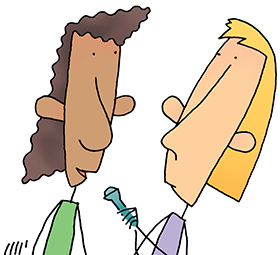Writing Simple and Compound Sentences

A simple sentence expresses just one complete thought. It can include multiple subjects, verbs, or phrases.
Ramón makes lunch.
He lifts the lid and stirs the macaroni noodles.
Too many simple sentences in a row make writing sound choppy. You can combine two or more simple sentences into a compound sentence using a comma and a coordinating conjunction (and, but, or, nor, for, so, yet).
He wants to turn on a fan, but his hands are full.
You can also use a semicolon to join two simple sentences into one compound sentence.
Steam rises from the pot; the kitchen feels like a sauna.
Identify the sentence type.
Read each sentence carefully. Label it with an S if it is simple and a C if it is compound. Make a copy of this Google doc.
- Ramón turns up the dial on the stove.
S
- Sweat pours from his brow.
S
- He is skilled at cooking, and macaroni and cheese is one of his specialties.
C
- The noodles soften in the boiling water; they are almost ready to eat.
C
- Ramón's sister thinks his oven mitts look goofy, but they protect his hands.
C
- Ramón turns off the heat and grabs a strainer to separate the water and noodles.
S
- The noodles are ready, so Ramón mixes in the cheese, milk, and butter.
C
- Ramón and his sister sit at the table and devour their lunch.
S
- Ramón wipes the sweat from his brow, and his sister wipes down the dishes.
C
- They both are ready to leave the sweltering kitchen and get back outside.
S
Create compound sentences.
Combine the two simple sentences with a comma and a coordinating conjunction (and, but, or, nor, for, so, yet). Make a copy of this Google doc.

- Emma writes for the school newspaper. She interviews many people.
(Answers may vary.) Emma writes for the school newspaper, so she interviews many people.
- Aliya is the new student council president. This is her first interview.
(Answers will vary.) Aliya is the new student council president, and this is her first interview.
- Emma greets Aliya with a friendly handshake. Aliya still feels nervous.
(Answers will vary.) Emma greets Aliya with a friendly handshake, but Aliya still feels nervous.
- Emma asks about a school talent show. Many students are talking about the idea.
(Answers will vary.) Emma asks about a school talent show, for many students are talking about the idea.
- Aliya loves the idea. She will add it to the agenda for the next student council meeting.
(Answers will vary.) Aliya loves the idea, and she will add it to the agenda for the next student council meeting.
- Organizing the event will take a lot of work. Aliya urges students to form a planning committee.
(Answers will vary.) Organizing the event will take a lot of work, so Aliya urges students to form a planning committee.
- Emma is excited about the possibility of a talent show. It could generate many great stories and photos for the newspaper.
(Answers will vary.) Emma is excited about the possibility of a talent show, for it could generate many great stories and photos for the newspaper.
- The girls could meet for another in-person interview. They could do their next interview online.
(Answers will vary.) The girls could meet for another in-person interview, or they could do their next interview online.
Use simple and compound sentences.
Respond to either writing prompt:
- Write a real or make-believe story about a cooking adventure or misadventure.
- Imagine you are a newspaper reporter. Write an article that describes what happened at a school talent show.
Improve the flow of your writing by combining at least two simple sentences into a compound sentence.